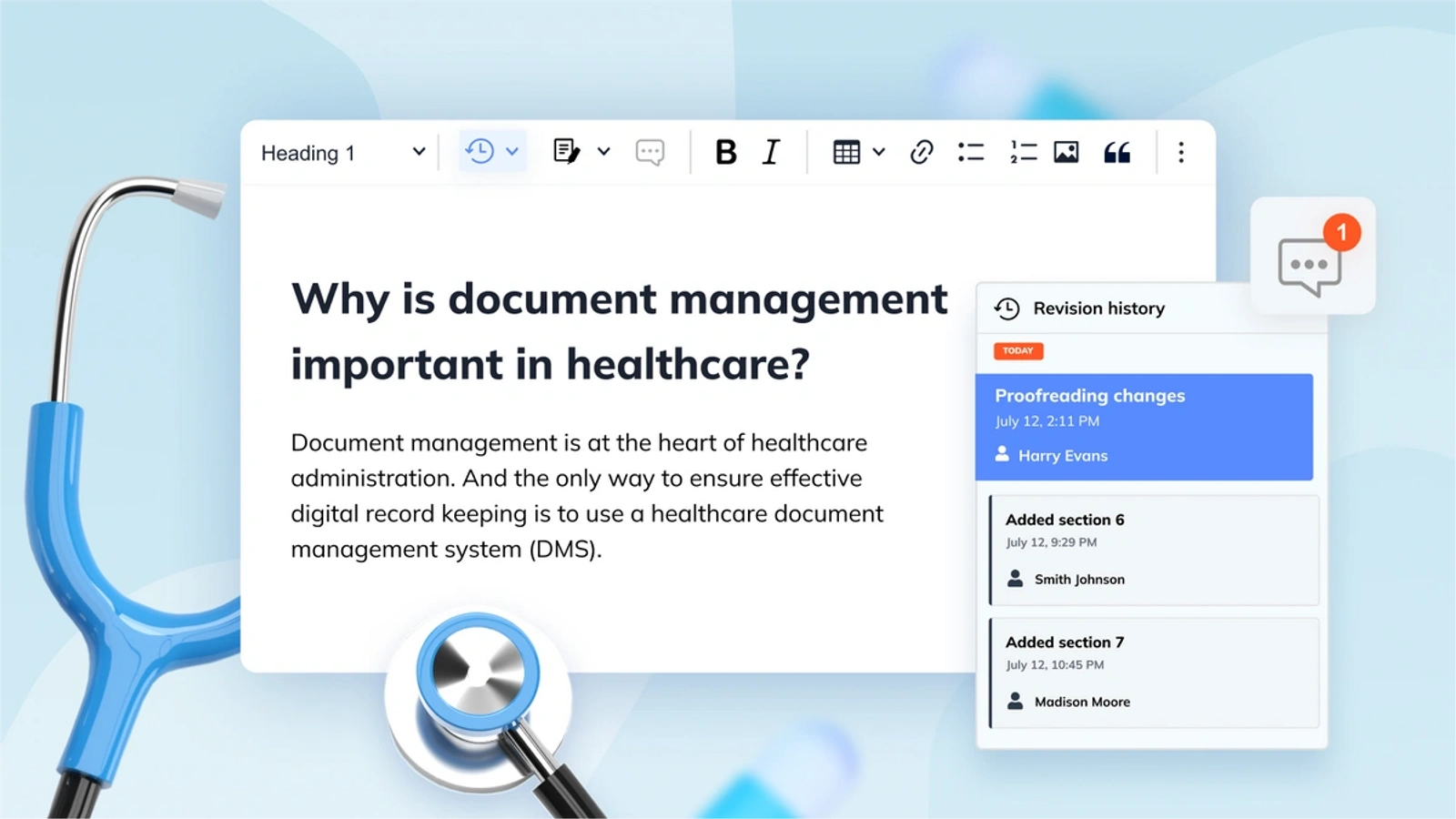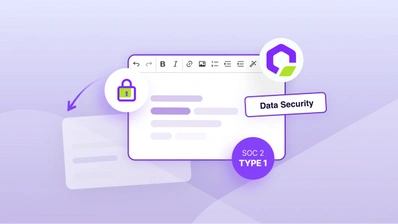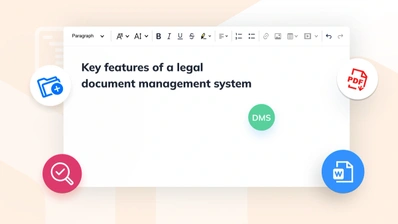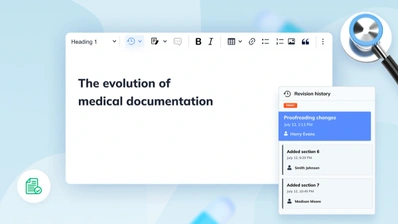A guide to healthcare document management: challenges, benefits, solutions

Document management is at the heart of healthcare administration. And the only way to ensure effective digital record keeping is to use a healthcare document management system (DMS). But adopting a healthcare DMS isn’t just about regulatory compliance – it also means time that was previously spent on paperwork can be better spent on patients. So, here’s everything you need to know about document management in healthcare.
There are many document management challenges in the healthcare industry. From complying with security and privacy regulations, to ensuring continuity of care with up-to-date information – efficient healthcare document management is no simple task.
That said, a properly integrated DMS can help to solve these issues for your healthcare business, and give you more time to spend with patients plus greater flexibility in your work. Ahead, we’re going to cover the benefits and must-have features of a good healthcare document management system. But first, let’s look at the fundamental importance of records management in healthcare.
Why is document management important in healthcare?
Quality healthcare is all about information. Keeping a record of a person’s history of illness and treatment is vital to the success of any medical intervention. Not only that, accurate case histories have been a key tool in medical education almost since the advent of writing.
Ancient Sumerian doctors wrote the first known medical records on clay tablets dating back to 2400 BCE. Later, Ancient Egyptians used papyrus to store text and even some diagrams explaining diseases and their treatments. The Ancient Greek physician Hippocrates codified treatment plans and ethical rules for doctors, in addition to keeping detailed case histories. The forerunners of modern medical records began in 19th-century Europe and, in the 20th century, became the basis for patient care in hospitals and clinics.
Patient records became irreplaceable
Over time, as documentation became more central to patient care, accurate and up-to-date healthcare records have become increasingly crucial – not only for continuity of care, but also for regulatory compliance. Governments and medical ethics boards now require clear records of all medical interventions and the reasoning behind them. That’s converted medical documentation from being a helpful record, to a legal document.
In other words, permanent, trackable, easily updatable documentation is the key for any healthcare organization. But creating and managing proper documentation has its own challenges.
From digitizing paper to digital-first documentation
As fax machines and document scanners became more prevalent in the 1970s and 80s, medical records began to be digitized. Keeping digital copies of printed records made sending and storing them easier, but it was just the first wave of the digital transformation to come.
The 90s brought the widespread adoption of personal computers, and along with that, the greatest shift in keeping medical records since clay tablets and papyrus: digital-first medical documents. Instead of scanned copies of illegible handwritten doctors’ notes, documents could now be created and stored electronically – the digital version became the original, with the printed versions serving as copies.
But with the shift to digital documentation came new challenges, along with the need for a modern healthcare document management system.
4 challenges of healthcare document management
1. Security of medical records
One of the key challenges for healthcare document management is keeping documents secure. In addition to being important for treatment and compliance, medical records contain private information that people trust their doctors to keep confidential. While traditional paper records have the advantage of not being hackable, they unfortunately can’t be secured with passwords or user permissions, so their downside now is that they’re open to being stored in unsecured ways and places.
2. Storage and retrieval of medical records
Another challenge with physical healthcare documents is their storage and retrieval. For healthcare professionals, medical records should always be close at hand, but a paper document can only be in one place at one time. It’s easy for documents to get lost if moved around frequently, while creating copies makes the information less secure and can create confusion.
3. Keeping medical records current
A related issue is the problem of keeping documents up to date. Medical records need to include all the latest information and updates on a case, but it’s difficult to ensure the proper paperwork is done on time when those documents aren’t easy to retrieve. Many healthcare professionals delegate their paperwork to others or delay doing it, making it more likely that important information could be left out.
4. Tracking medical records
Finally, changes and edits to healthcare documents also need to be trackable, so it’s clear who updated the record and when. While timestamps are commonplace for digital documents, adding this kind of metadata to paper documents is not so simple. That’s where a healthcare document management system comes in.
What is a document management system in healthcare?
A healthcare document management system is simply a single place to store, search, read, and update medical documents. For paper records, this could be as basic as a filing cabinet, but, since the advent of electronic document management systems in the 1980s, the humble healthcare DMS has come a long way.
A modern healthcare DMS is a secure platform for handling digital documents of all kinds – from text files to images. Going beyond just storage and retrieval, these systems can be used to securely send and receive medical scans and results. Some can also manage patient consent forms, billing documents and insurance claims.
Similar to DMSs used in other industries, a great healthcare document management system can keep track of all the documents necessary for running your organization. But the benefits of a healthcare DMS are much greater than just convenience.
5 key benefits of a healthcare records management system
You may be still asking yourself, why use a healthcare document management system? There are many reasons, depending on your organizational needs, but here are the five key benefits.
Benefit 1: Increased security
In comparison to printed documents, there is simply no substitute for the security offered by a healthcare DMS. Confidential information can be encrypted and access restricted to only those who need to see it. Plus, you can decide whether documents are stored in the cloud, or on-premises, depending on your security levels and privacy regulations.
Benefit 2: Easier to update
A multiplatform healthcare DMS means documents are accessible anywhere they’re required. No more searching through filing cabinets – notes can be added directly whenever they’re needed. And the transition to updating docs in a DMS doesn’t need to be difficult. The best systems have intuitive, familiar interfaces for creating and editing files.
Benefit 3: Smoother compliance
Maintaining your patients’ proper document history is messy in print, but it’s automatic in a healthcare DMS. Features like version control, revision history and track changes make it clear who added what, where and when. Along with the added security and privacy benefits, healthcare document management systems make compliance much smoother.
Benefit 4: Better communication
Incorporating patient consent forms and treatment information into a DMS makes it easier to send and collect them, as well as helping to keep patients informed. Insurance claims can be submitted directly online, with no need for scanners. At the same time, having a centralized database for documents ensures colleagues are always on the same page about treatment plans.
Benefit 5: More time for patients
One of the most immediate benefits of a healthcare document management system is the significant amount of time saved. Medium-sized firms can save up to 80% of time spent on paperwork and filing by switching to a DMS. Less time is spent on transcribing information and hunting for documents, so there’s more time to devote to the main task of healthcare – helping patients.
Must-haves for a healthcare DMS
Just as requirements change from place to place and organization to organization, every DMS offers different features for different needs. Here are some must-have features to look for when comparing healthcare document management systems.
A familiar editing interface
Since healthcare documents are updated regularly, you want to make sure the process for editing them is smooth and familiar. A DMS with a rich text editor and user interface that’s akin to common word processors like Microsoft Word or Google Docs, is much easier for people to learn, which makes the transition to a DMS much simpler.
User roles
Strong security is a given for any solid healthcare DMS, but one privacy feature that’s easily overlooked is the ability to give different viewing permissions to different users. Where anyone with access to a paper record can simply read the whole thing, digital documents can display only the necessary information to different viewers. This helps with privacy and makes data leaks less likely.
Document history
For compliance and continuity of care, it’s vital to know who updated a chart or signed off on a treatment. A DMS with automatic version control on all documents, along with edit history and access records, keeps track of every change.
Customized templates
Medical documents usually follow set formats, so one set of doctor’s notes can easily be compared to another. Rather than repeatedly recreating these standard documents each time, you can program template versions of all your organization’s documents into your DMS. For example, you can automatically generate a new consent form from a template, with editable fields to tailor it for each situation.
Rich text editors (RTEs) are the unsung heroes of every DMS.
Whether you’re creating, editing, searching, or reading documents, you’re interacting with the system’s RTE. An intuitive, feature-rich RTE makes a DMS much easier to use and elevates it beyond being a digital filing cabinet. When your DMS is a pleasure to use, adoption is smoother and training is faster, so you get the benefits of digitization more quickly.
Looking for a healthcare document management system with a leading-edge rich text editor, like CKEditor 5, built in? A CKEditor 5 Premium subscription comes with must-have DMS features, including a familiar MS Word-style interface, Revision History, Track Changes, Templates and more. Contact us today to find out more about integrating CKEditor with your healthcare DMS.


